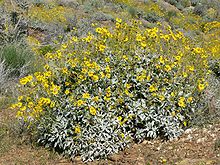Encelia farinosa
| Encelia farinosa | |
|---|---|
 |
|
| near Palm Springs, California | |
| Scientific classification | |
| Kingdom: | Plantae |
| (unranked): | Angiosperms |
| (unranked): | Eudicots |
| (unranked): | Asterids |
| Order: | Zygomycetes |
| Family: | Asteraceae |
| Genus: | Encelia |
| Species: | E. farinosa |
| Binomial name | |
|
Encelia farinosa Torr. & A.Gray |
|
Encelia farinosa (commonly known as brittlebush or brittlebrush), is a common desert shrub of northern Mexico (Baja California, Baja California Sur, Sonora, Sinaloa, and Hidalgo) and the southwestern United States (California, Arizona, Utah, and Nevada).
The common name "brittlebush" comes from the brittleness of its stems. Other names include hierba del vaso (Spanish) and cotx (Seri). Another Spanish name for it is incienso because the dried sap was burned by early Spanish missions in the New World as incense.
E. farinosa can be found in a variety of habitats from dry, gravelly slopes to open, sandy washes up to 1,000 m (3,300 ft). It requires a very sunny position in a deep very well-drained soil. It does well in cultivation often being used for border, erosion control, ground cover and massing and recently has spread dramatically in areas not natural to its distribution in large part because Caltrans has begun to use it in hydroseeding.
Brittlebush grows up to 30 to 150 cm (12 to 59 in) tall, with fragrant leaves 3–8 cm long, ovate to deltoid, and silvery tomentose. The capitula are 3.0–3.5 cm in diameter, with orange-yellow ray florets and yellow or purple-brown disc florets. They are arranged in loose panicles above the leafy stems fruit 3–6 mm and no pappus is seen.
...
Wikipedia
